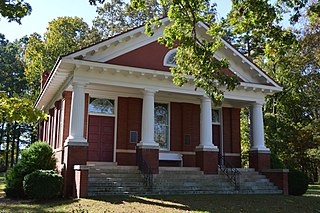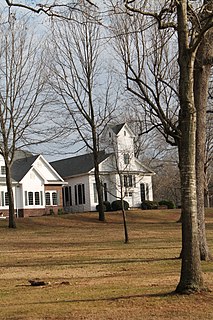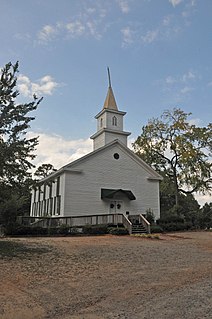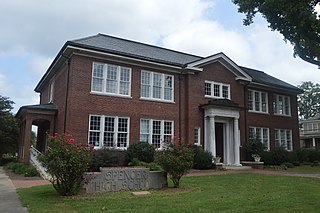
Crossnore is a town in Avery County, North Carolina, United States. The population was 192 at the 2010 census.

Warrenton Historic District is a national historic district located at Warrenton, Warren County, North Carolina. The district encompasses 202 contributing buildings in the central business district and surrounding residential sections of Warrenton. The district developed between about 1840 and 1926, and includes notable examples of Early Republic, Greek Revival, and Late Victorian architecture. Notable buildings include the Falkener House, Macon Street House, Peter Davis Store, Jones-Cook House, Eaton Place (1843), Sommerville-Graham House by Jacob W. Holt, Presbyterian Church also by Holt, Baptist Church, Methodist Episcopal Church, Miles Hardware Store, Warrenton City Hall, Warrenton Hotel, John Graham School, and the U.S. Post Office.

Griers Presbyterian Church and Cemetery is a historic Presbyterian church and cemetery located near Frogsboro, Caswell County, North Carolina. It was built about 1856, and is a simple, rectangular frame building. It is an example of Greek Revival temple-form church architecture. Also on the property is a contributing church cemetery.

Red House Presbyterian Church, also known as Hugh McAden Gravesite or Red House Church, is a historic Presbyterian church and cemetery located at 13409 NC 119 N in Semora, Caswell County, North Carolina. The Classical Revival red brick church building was constructed in 1913. It features a portico with four round, fluted wooden Doric order columns. Also on the property is a contributing church cemetery.

Bethesda Presbyterian Church, Session House and Cemetery is a historic Presbyterian church, session house, and cemetery located near Houstonville, Iredell County, North Carolina. It was built in 1853, and is a one-story, three bay by five bay, rectangular vernacular Greek Revival style frame church. It has an pedimented, temple form, front gable roof and an unusual front recessed balcony. It is the oldest church building in Iredell County. Also on the property is the contributing session house, also built in 1853, and church cemetery with about 200 gravestones.

Coddle Creek Associate Reformed Presbyterian Church, Session House and Cemetery is a historic Associate Reformed Presbyterian church located near Mooresville in Iredell County, North Carolina, United States.

Buffalo Presbyterian Church and Cemeteries is a historic Presbyterian church and cemeteries located at 1333 Carthage Street in Sanford, Lee County, North Carolina. It was built in 1879, and is a two-story, gable-fronted, Gothic Revival style frame building. The front facade features lancet-arched double-leaf entries, lancet-arched windows, and a three-stage projecting entry tower with a flared, pyramidal roof and finial. Associated with the church is the manse built in 1926. It is a two-story, hip-roofed frame dwelling with Colonial Revival detailing. Also on the property are the original church cemetery, a cemetery for African-American congregants, the Matthews family plot, and the main cemetery. It is the oldest Presbyterian Church in Lee County, Sanford, North Carolina. This is an active congregation of the Presbyterian Church USA.

Euphronia Presbyterian Church is a historic Presbyterian church and national historic district located at 3800 Steel Bridge Road near Sanford, Lee County, North Carolina. It was built in 1886, and is a two-story frame building with weatherboard siding and a gable-fronted nave form. It features a two-tier belfry rising from the roof ridge. Also on the property is a contributing church cemetery.

Hopewell Presbyterian Church is a historic Presbyterian church complex and national historic district located near Huntersville, Mecklenburg County, North Carolina. The church was built in 1833–1835, renovated and enlarged in 1859–1860, and expanded by a Sunday School addition in 1928. It is a "U"-shaped brick and brick veneer building composed of three connected blocks all covered with front-gable roofs. The church is a rectangular gable-front brick building standing on a low mortared fieldstone foundation and Greek Revival style design elements. Also on the property are the contributing pumphouse, cemetery gate (1845), and cemetery with burials dating to 1775. The cemetery contains one of the two largest collections of box and chest tombs in North Carolina. General William Lee Davidson of the North Carolina militia, killed in 1781 at the Battle of Cowan's Ford during the American Revolutionary War, is buried in the cemetery.

Bethesda Presbyterian Church is a historic Presbyterian church located on NC 5 in Aberdeen, Moore County, North Carolina. It was built in 1860, and is a two-story, vernacular frame meeting house. It rests on tall granite piers, is sheathed in weatherboard, and has a hipped roof. The front facade features a projecting two-stage bell tower. Also on the property is a contributing church cemetery.

Oak Plain Presbyterian Church is a historic Presbyterian church located near Waycross, Sampson County, North Carolina. It was built in 1859, and is a one-story, three-bay-by-three bay, temple form, Greek Revival style frame church. A steeple was added to the church building in 1976. Also on the property is the contributing church cemetery.

Milligan Shuford Wise and Theron Colbert Dellinger Houses is a set of two historic homes located at Crossnore, Avery County, North Carolina, United States. They were built in 1926 and 1927, and are rustic 1 1/2-story, frame American Craftsman-style houses. The Wise House is surrounded by contributing landscaping. Also on the property are a contributing garage apartment and stone one-story Wise Cottage.

Weaving Room of Crossnore School, also known as Home Spun House, is a historic school building located at Crossnore, Avery County, North Carolina. It was built in 1936, and is a 2 1/2-story, banked, vaguely Rustic Revival-style building constructed of randomly mortared river rock. It was built to house the weaving program of the Crossnore School, an orphanage with an industrial and vocational training program.

Crossnore School Historic District is a historic school campus and national historic district located at Crossnore, Avery County, North Carolina. It encompasses four contributing buildings and one contributing structure and are the oldest surviving buildings associated with the school established here in 1913. The buildings were built between 1928 and 1960, and constructed of stone, frame, or log construction, and stand 1+1⁄2 or 2 stories in height. They are the Daughters of the American Revolution Dormitory / Cooper Building, E.H. Sloop Chapel (1956), DAR Chapter House (1958-1959), Garrett Memorial Hospital / Edwin Guy Building, bell tower, and the separately listed Weaving Room of Crossnore School.

Downtown Asheville Historic District is a national historic district located at Asheville, Buncombe County, North Carolina. The district encompasses about 279 contributing buildings and one contributing object in the central business district of Asheville. It includes commercial, institutional, and residential buildings in a variety of popular architectural styles including Colonial Revival, Queen Anne, and Art Deco.

Hebron Presbyterian Church, also known as Sutton's Branch Church, is a historic Presbyterian church and national historic district located near Beautancus, Duplin County, North Carolina. The district encompasses one contributing building and one contributing site. The church was built in 1890, and is a small one-story, front gable, wood-frame Late Gothic Revival-style church. Also on the property is the contributing church cemetery with burials dating to 1902.

Star Historic District is a national historic district located at Star, Montgomery County, North Carolina. The district encompasses 85 contributing buildings, 2 contributing sites, and 3 contributing structures in the town of Star. The district developed between 1896 and 1963 and includes notable examples of Queen Anne, Romanesque Revival, Colonial Revival, and American Craftsman style architecture. Notable contributing resources include the Leach-Allen House and Wright Dairy, Leach Cemetery (1859), Star Railroad Depot, Bank of Star, Star Hotel (1896), Allen Building, Pontiac Dealership, Nalls Watch Repair Building/C. V. Richardson Hosiery/Star Town Hall, Star Methodist Church, and Star Presbyterian Church (1953-1958).

Reidsville Historic District is a national historic district located at Reidsville, Rockingham County, North Carolina. It encompasses 324 contributing buildings, 1 contributing site, 11 contributing structures, and 1 contributing object in the central business district and surrounding residential sections of Reidsville. It was developed between about 1865 and 1941, and includes notable examples of Italianate, Queen Anne, American Craftsman, and Classical Revival style architecture. Located in the district are the separately listed Penn House and Gov. David S. Reid House. Other notable buildings include the Oaks-Motley House, Colonel A. J. Boyd House (mid-1870s), Reid Block (1880s), Citizens' Bank Building, William Lindsey and company Tobacco Factory, First Baptist Church, Main Street Methodist Church, Melrose (1909) designed by architect Richard Gambier, R. L. Watt house designed by Willard C. Northup, First Presbyterian Church (1922), St. Thomas Episcopal Church, Grand Theatre, Belvedere Hotel, United States Post Office and Federal Building, and the Municipal Building (1926).

Spencer Historic District is a national historic district located at Spencer, Rowan County, North Carolina. The district encompasses 242 contributing buildings in the central business district and surrounding residential sections of Spencer. It largely developed between about 1902 and 1937, and includes notable examples of Queen Anne style architecture. Notable buildings include Cooke's Drug Store, the Julian Building, Wachovia-First National Bank Building (1903), Arey Building (1908), First Baptist Church (1926), Presbyterian Church (1903). Central Methodist Church (1921), Spencer Library (1913), Spencer Town Hall (1937), the John Hatley House (1901), and the Morrison House.

Salisbury Historic District is a national historic district located at Salisbury, Rowan County, North Carolina. The district encompasses 348 contributing buildings and 1 contributing site in the central business district and surrounding residential sections of Salisbury. It includes notable examples of Late Victorian, Colonial Revival, and Bungalow / American Craftsman style architecture. Located in the district are the separately listed Maxwell Chambers House, McNeely-Strachan House, Archibald Henderson Law Office, and the former Rowan County Courthouse. Other notable buildings include the tower of the former First Presbyterian Church (1891-1893), Rowan County Courthouse (1914), Conrad Brem House, Kluttz's Drug Store, Bell Building, Washington Building, Grubb-Wallace Building, Hedrick Block, Empire Hotel, St. Luke's Episcopal Church (1827-1828), Soldiers Memorial A.M.E. Zion Church (1910-1913), U.S. Post Office and Courthouse (1909), City Hall (1926), Salisbury Fire House and City Building (1897).


















